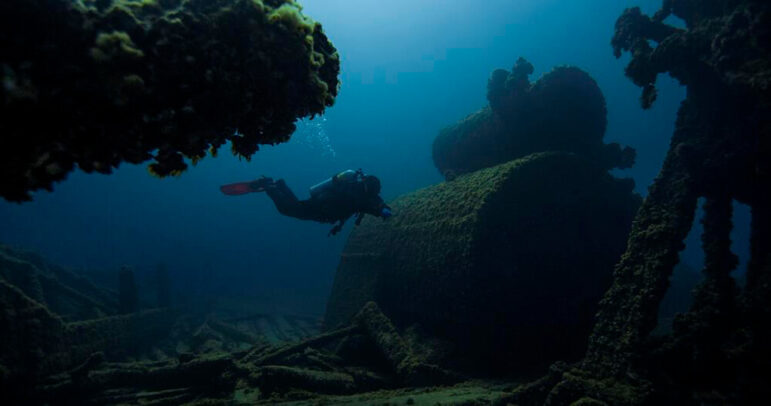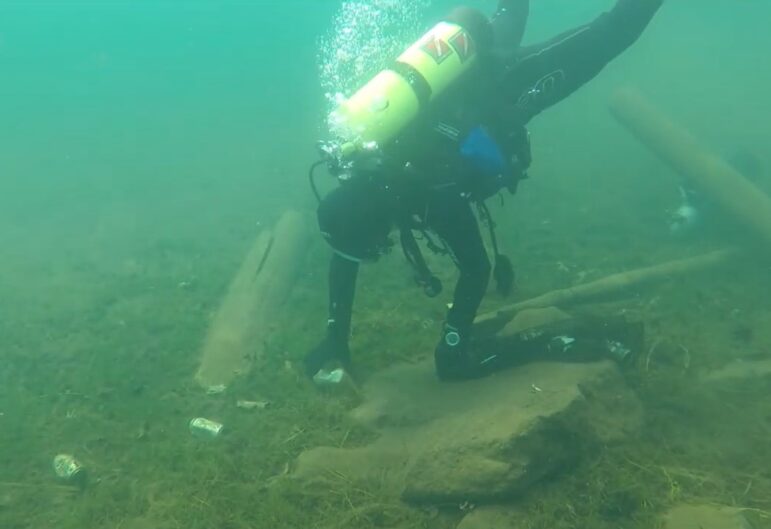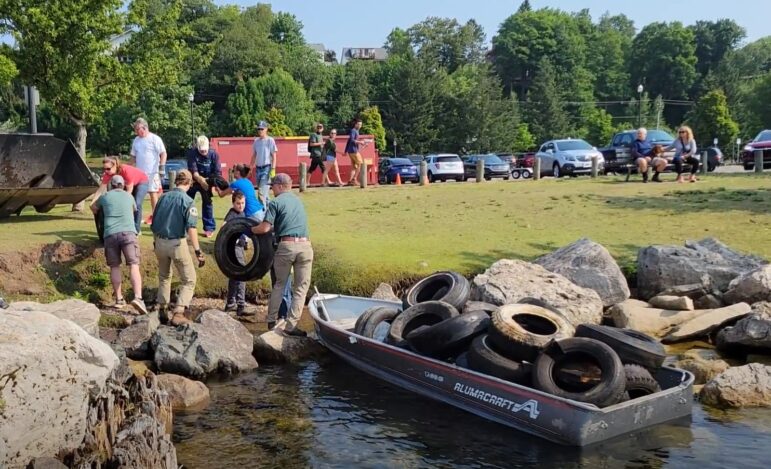
Don Fassbender
Many divers carry a junk bag to pick up trash they come across.By DANIEL SCHOENHERR
Capital News Service
“Drink ‘em and sink ‘em” was the practice of fishermen who threw their beer and pop cans and bottles into the Great Lakes over 40 years ago.
Don Fassbender, president of Great Lakes Scuba, a lake preservation dive club, once saw old cans underwater as far as he could see beneath Lake Superior. He posted a video of the dive on YouTube, showing the garbage he found and collected.
The video ends with Fassbender emptying out four dive bags full of cans and a message for viewers: “Let’s keep it clean, people…Be a part of the solution…Not the problem.”
Great Lakes can and bottle littering eased in 1976 when Michigan’s Bottle Deposit Law placed a 10-cent deposit on many beverage containers.
Nowadays it is plastic that gets the attention of scuba divers looking to clean up Great Lakes litter.
The Rochester Institute of Technology estimates that 9,887 metric tons of plastic pollution enters the Great Lakes each year. It washes up on shore and releases harmful chemicals into the water, researchers say.
State Rep. Denise Mentzer, D-Mount Clemens, wants to prevent plastic waste polluting the Great Lakes watershed by extending the deposit law to plastic water bottles.
“If there were a 10-cent deposit on water bottles, maybe we wouldn’t find them littered along every roadside, every median and in our rivers, streams and lakes,” said Mentzer, an avid diver.
“Wherever we dive, there’s debris, there’s trash,” she said.
Mentzer is planning an eco-dive cleanup in the Clinton River near Lake St. Clair for Aug. 26 that will be attended by Michigan Lt. Gov. Garlin Gilchrist.
Great Lakes divers organize many “eco-dives” to protect fish habitat and underwater preserves. Fassbender has been organizing annual eco-dives since 2019, including one at Marquette’s Lower Harbor Park last August.
Divers from across the Midwest pulled over 12 tons of trash at the bottom of the harbor.
“It’s out of sight, out of mind for a lot of people,” Fassbender said.
Kevin Ailes, the president of the Michigan Underwater Preserves Council, was part of that dive team.
“I’m always surprised at the volume [of trash], but nobody sees it but divers,” he said.
Most volunteers for eco-dives aren’t divers, Fassbender said. “Anyone can help…it’s a worthy cause.”
Volunteers transport and sort the trash that the divers pull from a lake and staff information tents.
Car batteries and refrigerators concern Ailes the most. They contain hazardous chemicals such as sulfuric acid and freon.
“We are the best line of defense against these sources of pollution,” Ailes said.
Scuba divers lead many of the Midwest’s underwater cleanups, Ailes said. “We are generally very environmentally minded people.”
Fassbender has long organized cleanup dives across the region. Others are just starting. Green Bay Scuba, a dive center in Wisconsin, organized its first last August at Shawano Lake near Green Bay.
“There was a big notice in the community that the lake was polluted,” said James Gill, a member of Green Bay Scuba and a certified Dive Against Debris diver. “There was a great turnout…we cleaned up quite a bit.”
Dive Against Debris, a specialty diving course provided by the Professional Association of Diving Instructors, teaches the basics of underwater cleanups, including what items should be removed from the water and how to successfully remove them.
Planning and organizing an eco-dive isn’t hard, Gill said. “It was mainly a matter of getting the community to support it.”
But actually doing them isn’t easy, Ailes said. After selecting skilled divers to be part of the cleanup team, the cleanup area needs to be scouted and markers need to be placed on bigger items during a preliminary dive. Permits also need to be obtained from departments which oversee cleanups, including sanitation and parks and recreation.
Ailes has found ski boats, cars and even airplanes during 1,000 dives.
“You name it, it’s down there,” he said.
Ailes has seen more young people taking interest in scuba diving and expects Great Lakes eco-dives to become more popular in the coming years.
“We’re ambassadors of a sport,” he said.
Many divers across the Great Lakes region have high hopes for the future of eco-dives, Gill said. “I think as long as people use their voice, the movement will grow.”

Kevin Ailes for the Thunder Bay National Marine Sanctuary.
One of the most dangerous trash items divers encounter is fishing line. They can drown if they get tangled in fishing line stuck to debris and shipwrecks.
Don Fassbender
A common trash item found in Great Lakes harbors are tires once used as bumpers for docking boats.
Don Fassbender
Don Fassbender and Kevin Ailes recover trash that has been underwater for decades. This car battery found in Marquette Harbor dates back to the 1950s.